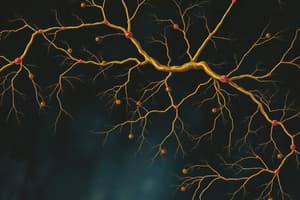Podcast
Questions and Answers
What is the direction of signal transmission from neuron to target cell?
What is the direction of signal transmission from neuron to target cell?
- Generally in one direction (correct)
- Bidirectional
- Only in exceptional cases
- In both directions, but with a delay
What is the characteristic of electrical synapses regarding the size and speed of transmission?
What is the characteristic of electrical synapses regarding the size and speed of transmission?
- Much smaller and faster than chemical synapses (correct)
- Only found in the peripheral nervous system
- Similar in size and speed to chemical synapses
- Larger and slower than chemical synapses
What is the function of connexons in electrical synapses?
What is the function of connexons in electrical synapses?
- Forming a barrier between neurons
- Regulating metabolic processes in glia
- Allowing large ions to pass freely between neurons (correct)
- Releasing neurotransmitters into the synapse
What is the process by which ACh triggers muscle contraction?
What is the process by which ACh triggers muscle contraction?
What is the role of ependymal cells in the CNS?
What is the role of ependymal cells in the CNS?
What is the characteristic of amino acids in neurotransmission?
What is the characteristic of amino acids in neurotransmission?
What is the difference between amines and peptides in neurotransmission?
What is the difference between amines and peptides in neurotransmission?
What is the percentage of peak action potential voltage in the synapse on hippocampus?
What is the percentage of peak action potential voltage in the synapse on hippocampus?
Flashcards are hidden until you start studying
Study Notes
Neurons and Synapses
- Neuron transmission occurs in one direction: from a presynaptic neuron to a postsynaptic neuron or cell.
- The presynaptic neuron is the first neuron, and the postsynaptic neuron or cell is the target cell.
Synapse Types
- There are two types of synapses: chemical and electrical.
- Chemical synapses involve the release of neurotransmitters, while electrical synapses involve direct electrical communication.
Electrical Synapses (Gap Junctions)
- Electrical synapses are much smaller and faster than chemical synapses, with a gap of 2-4 nm.
- They allow for bidirectional communication, with large ions passing freely between neurons.
- Gap junctions are composed of connexons, which are formed by six connexins.
- Mutations in connexins have been associated with congenital deafness.
Gap Junction Locations
- Gap junctions are found in glial cells, including astrocytes and oligodendrocytes, where they regulate metabolic processes.
- Gap junctions are also found between neurons, facilitating system coordination, particularly in inhibitory neurons in the neocortex and hippocampus.
- They can be found in excitatory pyramidal neurons and in the hippocampus, where they can reach up to 10% of peak action potential voltage.
The Neuromuscular Junction (NMJ)
- The NMJ is a chemical synapse at the end of a presynaptic motor neuron's axon.
- Studies of the NMJ established the principles of synaptic transmission.
Acetylcholine (ACh) and Muscle Contractions
- ACh binding at the NMJ causes muscle contractions.
- ACh triggers an action potential in the endplate of the muscle, which is coupled to muscle contraction through excitation-contraction coupling.
Non-Neuron-to-Neuron Transmission
- Not all transmission in the CNS occurs neuron-to-neuron; some occurs through volume transmission.
- The ventricles contain cerebrospinal fluid (CSF), which can contain nutrients and hormones that assist with neuronal communication.
- Ependymal cells lining the brain ventricles interact with neurons to cause the release of chemicals into the CSF.
Neurotransmitters
- Neurotransmitters are classified into three categories: amino acids, amines, and peptides.
- Amino acid examples include glutamate, glycine, and GABA.
- Amine examples include dopamine, acetylcholine, and histamine.
- Peptide examples include dynorphin and enkephalins.
Studying That Suits You
Use AI to generate personalized quizzes and flashcards to suit your learning preferences.




